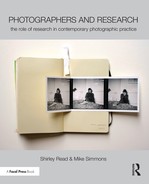Case Study
Deborah Bright
Deborah Bright is a photographer, scholar, art and visual culture historian, writer and Chair of the Fine Arts Department at the Pratt Institute in New York.
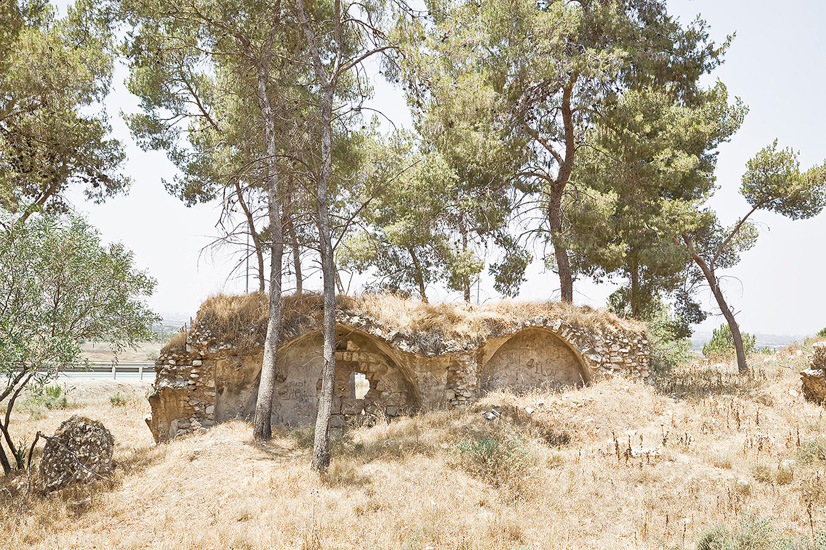
Destruction Layer: Palestine In Israel (2006-09), Ruins of Qula, near Lydda (Lod)
The site of Qula, a former village of 1100 Palestinians, is situated along a busy north–south highway connecting Lod (Ben Gurion Airport) to the Jewish exurb of Rosh Ha’yin. Qula was built on a hill overlooking a fertile plain and incorporated the remains of a Crusader fort. In 1948 it was the site of bitter fighting and atrocities were reported on both sides. Its stone and adobe houses and mosque were dynamited after the war (a school remained as late as the 1980s); however, the Crusader ruins were conserved as an archaeological attraction. As is common throughout Israel where villages were demolished, the Jewish National Fund overplanted the site with pine trees to create a public nature park.
© Deborah Bright
RESEARCH, AS I UNDERSTAND IT, is all of the thinking, planning, investigating and information gathering required for a photographic project; labour that is immanent in the work itself. In my own landscape photography spanning 35 years, research is threaded throughout the process of bringing a given project to fruition. It is a matter of educating myself on my subject so that the story the images tell is as richly imagined as possible for a contemporary audience.
I don’t have any set formulas for how I go about selecting and researching a subject though there is a fairly consistent path in how I proceed. I begin, as artists often do, with a hunch, an intuition. Of course, that intuition is not random but channelled by my individual sensibility, a way of thinking and seeing that has evolved over many years of working behind the camera and making and looking at photographs. Most of my landscape projects have to do with conquest and the obliteration of memory—who gets to tell the official story and whose stories are suppressed, though never completely destroyed. So, I see my research as a kind of excavation, doing the digging to find clues, to render visible what is neither seen on the topographical surface nor marked on maps or signage.
Once a particular landscape or type of landscape has captured my attention, I want to learn everything I can about it—its histories, its political and economic fortunes, who else has photographed it, what legends or stories have circulated about it, its quirks and anomalies, its meaning (or lack thereof) for people today. It is only in this way that I can sort out the details that I want to look for when I’m back on the site, to see what visual signs will serve as my ‘punctums’ or have a synecdochical function where the photographed detail points to a larger concept or truth.1 It is the relationship between my understanding gained through the research and the material presence of the site that is crystallised in the work. The research guides me as to where to look for what may be difficult to see after decades of neglect in what are often viewed locally as wastelands or latent sites for ‘development’.
As a process research fosters deeper understanding by illuminating the historical record and previous documentation (visual and written) of the subject. This can help photographers sharpen their framing and point of view, to find the telling details that will make the subject come alive visually. It is often interesting to re-photograph a subject that has been documented in the past, to see how it has changed over time and what this tells us about changing politics and economic realities. The ‘rephotographic surveys’ of places photographed by nineteenth-century explorers in the American West, for example, tell us much about changes over time and how the land is, or is not, valued.2
As for how foregrounded a photographer’s research needs to be in the final presentation of the work, this can be evaluated through the choices the photographer makes about its destination—whether a commercial art gallery, community or educational exhibition space, published monograph, newspaper, National Geographic, or on Instagram. The only contexts where the outcomes of research carry considerable weight for viewers are traditional documentary or journalistic enterprises where the ‘truth value’ or believability of what is shown needs to be verifiable across multiple sources. These kinds of projects tend to feature situating texts and often take the form of the photo-essay published in a magazine or in book form (or on a blog or website that aggregates such projects).
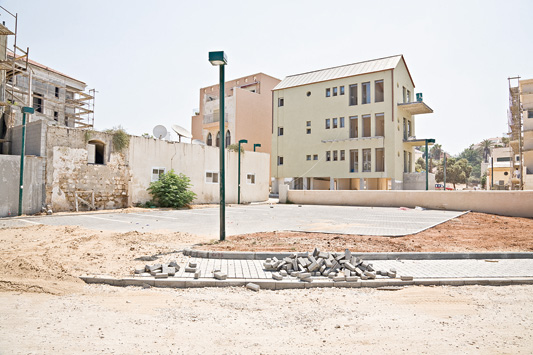
One of the most ancient cities in the world, Jaffa was a vibrant centre of affluent and middle-class Palestinian life before 1948. Terrorist attacks by Jewish nationalists (Irgun) precipitated the flight of 50,000 Palestinians, leaving behind around 5000 to guard family property and businesses. After the war, Israeli authorities forced this remnant into the ‘Ajami quarter where they were densely crowded into available housing. Because of its seaside location and proximity to Tel Aviv, ‘Ajami is undergoing intensive gentrification. Its Palestinian inhabitants have their homes demolished for the slightest infraction of building codes and the property is confiscated for Jewish development. This photograph shows a surviving Palestinian compound in northern ‘Ajami, surrounded by new Jewish housing.
© Deborah Bright
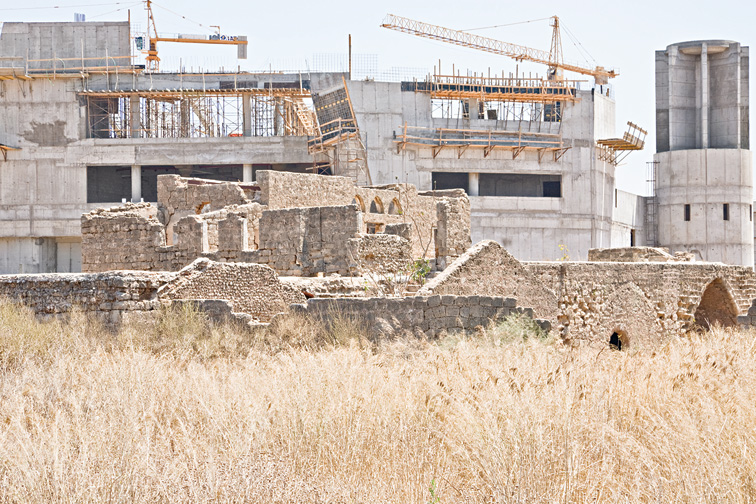
Ruins of a large compound, village of Bayyarat Hannun, just south of the city of Netanya, along the main highway from Tel Aviv to Haifa. In 2006, the shell of this two-storey structure was still surrounded by acres of citrus orchards and cultivated fields. In 2007, construction began on a new soccer stadium and this view was made in July 2008. Rumor had it that the ruins are to be restored as a concession area for sports fans.
© Deborah Bright
Though research may play a key role in the formation of work shown in an art gallery or art market context, it is usually minimised in the presentation in favour of an emphasis on the artist’s personal vision and the degree of formal innovation evident in the images themselves. At most, there will be a reductive Artist Statement at the reception desk (or on the museum wall) that frames the larger context for the work. In such contexts, the research is latent/implicit in the work rather than made obvious in the final presentation.
As I tend to work on photographic projects over several years, and because I am not meeting imposed deadlines, I have the luxury of integrating photography and research in a very organic way. Sometimes my projects will be triggered by something I’ve read or heard about that seizes my imagination, so then I try to find if that ‘thing’ can be seen and captured in the camera. Other times I will observe a phenomenon ‘in the street’, so to speak, make some preliminary photographs and then research the subject after the fact to enrich my understanding of it before I return to photograph it more consciously. As a landscape photographer, who is interested in histories of places over time, I work both ways. I find that this fluid interchange is important to my process and is the reason why my projects tend to unfold over years, rather than weeks or months.
This slow pace of working is also determined by my life as a full-time educator that limits me to summers or sabbaticals for any distant travel I need to do. But I keep the projects alive during the non-travel periods by researching and reviewing my documentation to see what I might have missed that I need to address on the next visit. In addition, I go to exhibitions and read reviews to see what other photographers are doing in terms of exhibition or publication strategies. This helps me think about possibilities for producing the final work and what formats would be most effective for reaching my intended audience(s).
The oscillation between research and production is a fluid one during the investigation phase and the photographing phase. There is both the visual investigation (locating the site, trying different camera angles, times of day, seasons of the year, choices of framing or sequencing), and text-based investigation (related historical, political, economic, folkloric or anecdotal materials). Such texts might include land ownership deeds, town records and microfilms of old newspapers, historical archives, blogs or websites devoted to the subject. In all cases I will read as deeply as I can about the histories of my subject (a particular place or landscape) while making repeated visits to the site(s) to photograph.
I will use art and photo history research to see how other artists or photographers with similar goals have approached their subjects. And if photographing in a challenging foreign environment I will do research specific to that location and culture so that the equipment and necessary preparations are made in advance for access to the intended subject and for visas, translators, fixers, transport, etc. Local historical societies are splendid resources for finding materials and people who have a relationship to the subject to interview—such as local residents of a place who know it well and can point out key details, or interviews with activists and planners who have information to contribute.

Dome and minaret of the al-Omri Mosque in the old centre of Tiberias, viewed from the unfinished mezzanine balcony of an adjacent shopping mall. Tiberius was built by the Romans as an imperial city on the Sea of Galilee and its Arab and Jewish residents had coexisted peacefully for over a millennium. That ended in April 1948 when the city’s 6000 Palestinians were encouraged by the retreating British army and Jordanians to evacuate their homes and were forbidden to return after the war.
© Deborah Bright
So, there is a constant reiterative process of looking, thinking and researching that bubbles along, much like a pot of soup on a stove. It has to cook for a time until the flavours mature. The assessment comes in the taste of the soup—is it delicious? What needs added to be the pot? Are the ingredients enhancing the flavour of the whole, or are some giving a bad taste? Should I bake a quiche instead? Should I toss the whole thing out and move on to something else?

Olive Grove and Garbage Dump, Lydda (Lod)
In 1948 there were 300,000 inhabitants of the city of Lydda, largely “Christian Arabs” who revered the birthplace of St. George whose medieval basilica still stands in the old center. Most of Lydda’s population was expelled in July 1948 and forcibly exiled to what became the Jordanian-controlled West Bank. Renamed Lod, the city has been the site of violent unrest between its native inhabitants and encroaching Jewish high-rise developments. Palestinians are often prevented from harvesting olives, so the groves grow untended and neglected. This one has become part of a dump on the outskirts of town.
© Deborah Bright
The project featured here, Destruction Layer: Palestine In Israel (2006–09), began as an extended conversation with Linda Dittmar, a film and literature scholar and third-generation Israeli whose grandparents immigrated to Palestine in the decades before it was partitioned and Israel was recognised as a state in 1948. Over the many years of our relationship, I became increasingly aware of the complexities of Palestine/Israel’s torturous historical trajectory in the twentieth, now twenty-first, century; of the political and religious allegiances within Israeli society and how these have changed and continue to change; of western colonialist adventures in the Middle East; of a century of diplomatic blunders, bad faith and missed opportunities on all sides; of the agendas that animate both Palestinian and Jewish extremists who would sabotage movement towards a negotiated compromise that might bring long-term stability and peace to both peoples.
I made my first trip to Israel with Linda in 2005, but as a tourist with little inkling of what I would find photographically, or whether it would even be possible for a non-Jewish American to undertake any politically charged project in that country and have credibility. Though she was an impeccable ‘insider/informant’ who spoke Hebrew and read Arabic, Linda was ambivalent as well about researching and photographing the remains of depopulated Palestinian villages inside Israel. It was not that she supported Jewish Israeli attitudes and policies toward the Palestinians—far from it—but the project was heart-wrenching because of her deep emotional ties to the country and her family’s history there.
What we both knew was that a photographic project as potentially controversial as this one would have to be accurately researched and verifiable as to the ‘facts on the ground’, or it would be dismissed as anti-Israel propaganda. The degree and depth of research was undertaken with as much care and corroboration by multiple sources as possible. Fortunately, we were greatly aided in our research by Zochrot, a Tel Aviv-based organisation of Israeli peace activists committed to preserving the memory of the Nakba (Arabic for ‘catastrophe’), the depopulation of approximately 400 Palestinian towns and hamlets seized by Israeli forces or temporarily evacuated during the hostilities of 1947–49. I was exceedingly pleased to contribute photographic images from my project that Zochrot could use in their oral history work with displaced Palestinians, both within Israel and the Occupied Territories.3
Exhibition context will always be a critical matter as Destruction Layer is likely to be viewed with scepticism, even hostility, by those with a stake in the Israeli-Palestinian conflict. This is particularly true in the US with its large Jewish community that tends to close ranks where criticism of Israel is concerned. But the scepticism isn’t just on one side. When we presented a slide talk to an audience that was sympathetic to the Palestinian cause, we were accused of minimising the Palestinians’ plight in the present by focusing on events from the past.
Our feeling was that we would share the work with whoever would invite us to speak and this worked most successfully in university settings where controversial political material is more open to examination and discussion. As places to exhibit such work in the US, universities have been more open to taking risks and are best equipped to mediate conflicts through discourse (though self-censorship and caving in to vocal pressure groups can and does occur). Commercial galleries and art institutions that depend on the goodwill of private collectors and corporations will not host politically controversial work—that is a given. More discouragingly, the art world has spawned a potent critical apparatus that judges politically charged subject matter and artistic excellence as mutually exclusive categories. So, this effectively limits the venues for showing this kind of work, though it doesn’t dampen my enthusiasm for making it.
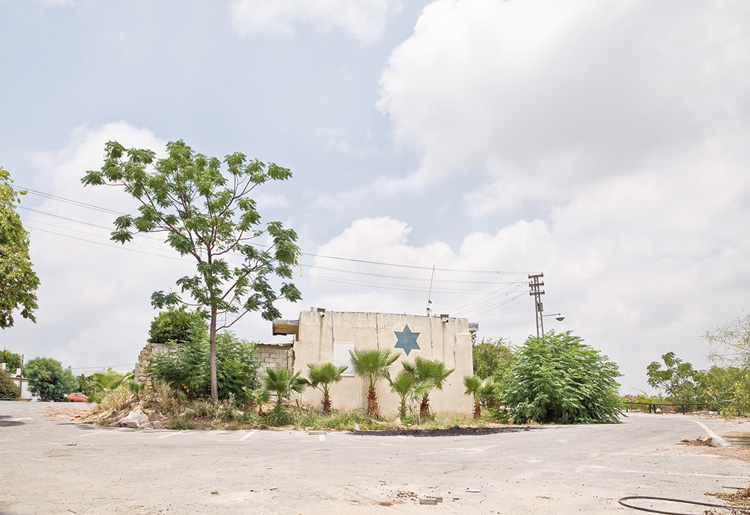
House in Sheikh Muwannis village
The village of Sheikh Muwannis was located just north of Tel Aviv. In March 1948, two months before the British ended their governance of Palestine and the State of Israel was declared, Jewish residents from Tel Aviv began taking over the houses in Sheikh Muwannis. A number of dwellings still remain, though most of the village was destroyed to make room for the campus of Tel Aviv University. The village head’s palatial home now serves as the university’s Faculty Club.
© Deborah Bright
The fluid relationship between research and production can take many different turns, depending on the subject and the conditions. In an early project, How
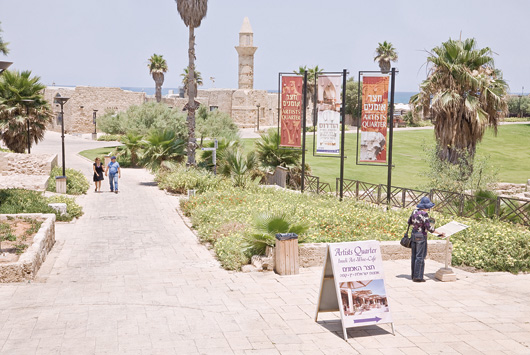
Village Mosque in Qesariya (Caesarea)
During the Ottoman era, a moslem diaspora from Bulgaria built its village on the site of ancient Caesarea, the Mediterranean port built by Herod the Great. Qesariya was the first Palestinian village whose inhabitants were methodically expelled in 1948 by Jewish forces and most of its houses were destroyed. The remaining buildings and shuttered mosque function as concession areas for a monumental archaeological park with many tourist attractions, including this “Artists Village.”
© Deborah Bright
The West Was Won/Caution: Do Not Dig (1985–87), I began with a very local site known to few, a public forest preserve near Chicago where the world’s first nuclear test reactor had been built as part of a top-secret installation during the Second World War. It was a fascinating place: a forested recreation area punctuated by detritus of ruined buildings and a few official markers. At first, I thought I’d make a series of composite panoramic photographs of the site in the vein of my Battlefield Panoramas (1981–84). But as I read more deeply about the history of the Manhattan Project, I realised that there was another story to tell about the revived sense of ‘manifest destiny’ that military men like General Leslie Groves experienced; that the achievement of winning the war with the atomic bomb was akin to the glorious ‘winning’ of the American West in the previous century. So, the research led me to expand the scope of the project and change its form. What began as a rather straightforward photographic document evolved into a time-based installation work, a format (pre-digital era programmed slide projection) better suited to the more complex story I wanted to tell.
From there I moved to creating a series of complex installation works before returning to more traditional photographic formats. The largest of these in scope and scale was the series of installations titled All That Is Solid (1992–2001). Rather than installing the same objects/images in different locations, I realised from my research and investigative photographs that the project needed to be shaped differently for each location (Chicago, Boston, Providence, Atlanta, Buffalo). The overarching concept of All That Is Solid (the effects of de-industrialisation and the redevelopment of former industrial districts) needed to be reflected through the peculiar local details of those places and so the final form and components of each installation differed from one location to another. So one might say I was testing my concept anew each time I changed the site of production and exhibition.
My other line of photographic work, having to do with more autobiographical material, is less research driven than my landscape work, though it is indirectly informed by the feminist and queer histories and literatures that I’ve absorbed over many years as an educator, writer and activist. But the starting point for these projects (Dream Girls, 1989–90, Being and Riding, 1996–99, Fleurs du Mal, 2007–) is my own experience growing up in the 1950s and 1960s. These projects are not driven by any external motive—beyond the relative historical paucity of images by lesbians of their emotional worlds—but by my own pleasure in realising them.
The arts give one great freedom to court chance and intuition in the making of the work; indeed, epiphanies and leaps of imagination are the artist’s holy grail—the wilder the leap, the more potentially valuable the result. This is not the case with traditional scholarly research that is, by its nature, conservative. If an academic researcher has an intuitive grasp of a startling new idea or fresh approach, she will need to build her case carefully through argument and citation in peer-refereed journals and is likely to be met with vigorous resistance should her insight challenge more established views. Artists—in the west, at least—are encouraged by their teachers and peers to be unorthodox, to be disruptive. This thinking is intrinsic to modernist consciousness (though artists no longer make grandiose claims about being an avant-garde!) Another observation: Absurdity and playfulness are highly valued in the creative arts but would not have much purchase in the realm of academic research. It’s not that scholarly approaches are in conflict with artistic approaches to knowledge creation, it is just that they operate at different speeds and play by different sets of rules. They
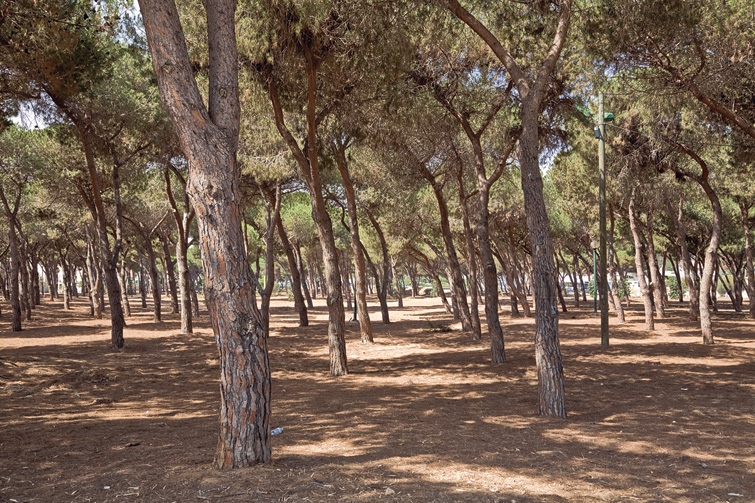
Pine Grove, Abu Kabir (Tel Aviv-Yafo)
The village of Abu Kabir was located southeast of Jaffa, the primary port of Palestine and at the heart of the flourishing citrus industry that made Jaffa oranges world famous. Where orange groves once flourished, pine groves have been planted which render the soil too acid for cultivation. A few scattered houses, commercial buildings, and a large vandalized cemetery remain from Abu Kabir which is gradually being swallowed by new road- building and high-rise development.
© Deborah Bright
can be in very productive tension with each other.
Research, chance and intuition are interrelated within my process and each is necessary to the outcome. Chance is key to any creative practice and every photographer and artist understands it, courts it and is grateful to it for its gifts. The lens ‘sees’ faster than the mind can absorb and we often find things in the images that we didn’t notice when we were standing on the spot. I think of the exploratory phase of any photographic project as a crucial form of note-taking or sketching, though a few remarkable images may materialise early on. One is feeling one’s way around the subject, observing what is present, what can be shaped in the viewfinder (and what cannot) and what might need supplementation (by archival material or text, etc.). A concept can feel quite inchoate and may take many months of looking and thinking to gel into a project, if it ever does. In my studio, there are boxes of unfinished projects where I did the preliminary photographic work and research, but the form of a finished project never crystallised, or I ran out of patience, or a more compelling project overtook me and I shelved the work. A later spark of chance or changing contexts might resuscitate these projects, or they may languish as vestiges of lively notions that lost their way.
It is also true that there are no certainties and rather little that we photographers/ artists can control. (Buddhists might say that any sense of control is an illusion and, as I get older, I increasingly think they’re right.) The lessons of the creative process (staying engaged in the moment and being open to whatever happens) happen to be those that best sustain us in the larger project of living our lives.
Interview by Shirley Read by email
Notes
1 Writing in Camera Lucida, Roland Barthes put forward two discrete responses, which can connect the viewer to the image. One he described as the studium, something that is interesting and appeals to the intellect. The other was far more visceral and emotional, which Barthes termed the punctum. R. Barthes (2004). Camera Lucida. London: Vintage.
2 See, for example, Mark Klett and William L. Fox (2004). Third Views, Second Sights: A Rephotographic Survey of the American West. Albuquerque: Museum of New Mexico Press. Also www.thirdview.org/3v/home/index.html.
3 See www.zochrot.org/en.
